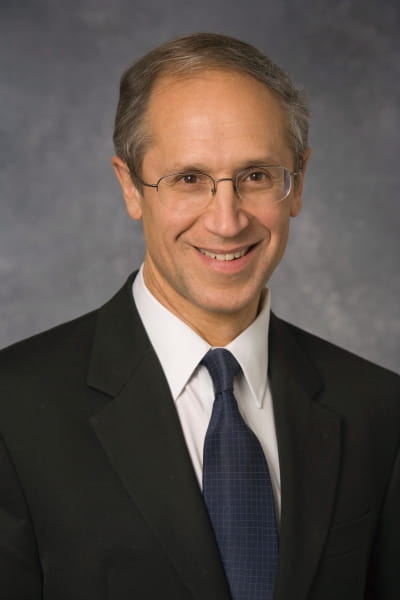Gene Therapy and Glioblastoma
January 24, 2017
Novel UH trial creates greater bone marrow tolerance to chemotherapy
 Andrew Sloan, MD, FACS
Andrew Sloan, MD, FACSInnovations in Cancer – Winter 2017: View Full PDF
In a federally approved clean room in the Cellular Therapy Lab at the Case Comprehensive Cancer Center, clinicians and technicians remove bone marrowderived stem cells from glioblastoma patients to create stronger cell tolerance to sophisticated approach to cancer therapy.
This Phase I clinical trial is yielding increased survival rates among selected glioblastoma patients at University Hospitals Seidman Cancer Center, where the clinical protocol was written by Andrew Sloan, MD, Director of the Brain Tumor and Neuro-Oncology Center and the Peter B. Cristal Chair of Neurosurgical Oncology. Dr. Sloan recently received the Neuro-Oncology Award for this trial at the 2016 Annual Meeting of the Congress of Neurological Surgeons in San Diego.
 Stanton L. Gerson, MD
Stanton L. Gerson, MD"This trial was designed specifically to protect the bone marrow from damaging chemotherapy", says Stanton L. Gerson, MD,Director, University Hospitals Seidman Cancer Center and Case Comprehensive Cancer Center at Case Western Reserve University; Asa and Patrick Shiverick - Jane Shiverick (Tripp), Professor of Hematologic Oncology, Case Western Reserve University School of Medicine. “We’re changing the DNA in their stem cells. We developed this concept 15 to 20 years ago, and only a few cancer centers in the country have been in existence and doing cell therapy as long as we have been.”
A COMPLEX PROCESS
The novel glioblastoma trial involvesremoving hematopoietic stem cells from the patient’s body, reengineering them in the lab and then retransplanting them. By introducing a drug-resistant gene, the treatment team can escalate the chemotherapy dose without as much concern for the toxicity to the bone marrow.
The process is challenging. Stem cells can be difficult to define, manipulate and keep viable in a culture outside the body. It is critical that the gene is placed in a stem cell that can differentiate from other mature blood cells in the body. “We did extensive safety studies to make sure the gene did not insert into the DNA in a place that would lead to unwanted gene activation,” says Jane Reese-Koc, MBA, MT, Operations Director of the Cellular Therapy Lab, adding that the lab is required by the U.S. Food and Drug Administration to track all gene insertions.
“Thus far, the trial has been safe for our patients,” Dr. Gerson says. “Glioblastoma multiforme is a tough disease. It’s one in which if we can give them more chemotherapy and they can tolerate it, they may do better. This trial gives the patient an opportunity to be involved in a new treatment. We really do partner with our patients as participants.”
For more information on this trial, email CancerInnovations@UHhospitals.org.
Tags: Brain Tumor, Glioblastoma, Stem Cell, Clinical Trials


